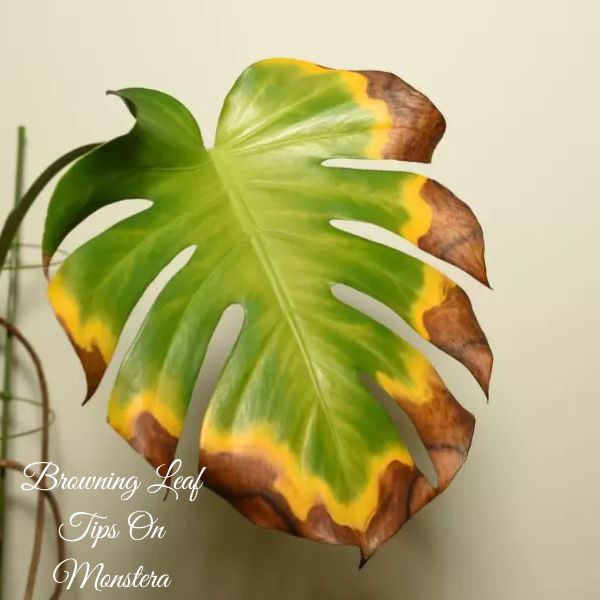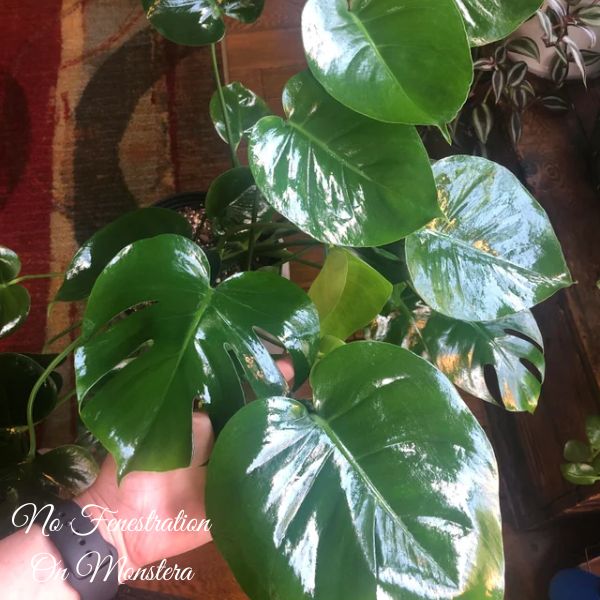The Monstera plant, with its captivating, split leaves, has become a beloved addition to many homes and indoor gardens. Hailing from the tropical regions of Central and South America, this stunning houseplant is known for its adaptability and resilience. But, to keep your Monstera happy and growing, you gotta understand its light needs.
A frequently asked question among plant lovers is, “Do Monsteras like direct sunlight?” or “Does Monstera like direct sunlight?” In this guide, we’ll tell you what Monsteras prefer, discuss the consequences of incorrect lighting, and share valuable tips on how to create the perfect lighting environment for your Monstera plant.
Do Monsteras Like Direct Sunlight? Understanding Their Natural Habitat
No, Monsteras do not like direct sunlight. They’re rainforest plants, used to living under lots of leaves and big trees, so not much direct sun gets to them. Instead of growing tall, With the aid of its aerial roots, the Monstera plant frequently climbs nearby trees and plants. They do this to get to brighter areas for more light, but not direct sun.
The unique holes in Monstera leaves let light get to the lower parts of the plant. It shows how the plant has adapted to its dimly lit home. Direct sun can hurt Monsteras, causing their leaves to burn or look like they’re tanned. To keep your Monstera healthy and growing, you need to control the lighting and make it like the indirect light they get in their natural home.
The Consequences of Too Much Direct Sunlight on Monstera Plants
Monsteras are from the tropics and can’t handle too much direct sun. The negative effects of Monstera too much sun include:
- Excessive Drying: Too much sun can heat up the plant’s pot, and dry out the soil. Monsteras require evenly moist soil to thrive, and the stress from dry soil can harm the plant’s overall health.
- Lack of Humidity: Direct sun not only dries the soil but also cuts the air’s humidity. Putting your Monstera in direct sun can cause low humidity problems, which aren’t great for this tropical plant.
- Browning Leaves on Monstera: Too much sun, low humidity, and dry soil can make your Monstera’s leaves turn brown and get crispy along the edges.
- Leaf Scald: The tender leaves of Monstera plants have adapted to absorb energy from bright, indirect sunlight in their natural rainforest habitat. If they get hit with bright direct sunlight, Monstera leaves can burn or scald and look pale or white. This damage can stop the leaves from photosynthesizing, which they need to do to grow healthily.

Understanding the consequences of excessive direct sunlight on Monstera plants is super important for maintaining their well-being and ensuring they continue to thrive in your home.
Creating the Perfect Lighting Environment: Ideal Light Conditions for Monsteras
To make sure your Monstera plant grows well and stays healthy, it’s super important to make the light like it is in its tropical home. Here’s what you need to know about providing the ideal Monstera light requirements:
- Bright, Indirect Light: Monsteras thrive in bright, indirect light. This lighting mimics the dappled sunlight that filters through the dense canopy of the rainforest. Place your Monstera near a window that gets lots of natural light, but make sure it’s safe from harsh direct sunlight, especially during the strongest sun hours.

- Eastern or Northern Exposure: Windows on the east or north side is great for Monsteras because they give lots of indirect sun without the danger of strong direct rays. Windows facing south or west could expose your Monstera to the stronger sun, so you gotta use curtains or blinds to filter the light or move your plant away from the window.
- Rotate Your Plant: If you rotate your Monstera regularly, all its leaves get the same amount of indirect sun. This helps the plant grow evenly and stops it from leaning toward the light.
- Supplement with Artificial Light: If you don’t have much natural light, you can use artificial lights to meet your Monstera’s light needs. Fluorescent lights or LED grow lights can give your plant the light it needs to grow and be happy.
- Monitor and Adjust: Keep an eye on your Monstera’s growth and health to see if it’s getting the right amount of light. If you see signs of stress, like leaves turning yellow or brown, change the plant’s spot or the lighting.
By understanding and providing the perfect light for your Monstera, you’ll make a great environment where it can grow brightly.
Recognizing the Warning Signs: When Your Monstera Needs More Light
If your Monstera isn’t getting enough light, it might start to look unhappy or have poor growth. It’s super important to spot these signs so you can make changes and help your Monstera thrive. Here are four signs that your Monstera might need more light:
- Lack of Fenestration: One cool thing about Monstera leaves is the fenestration, or splitting, that makes them look special. If your grown-up Monstera plant isn’t getting split leaves, it might need more light. Make sure your Monstera gets plenty of bright, indirect light for healthy leaf growth and fenestration.

- Slow Soil Drying: Monsteras like their soil just right – not too dry, not too wet. If the soil in your Monstera’s pot is taking too long to dry out, it might need more light. Move your plant nearer to a window or a brighter spot to help the soil dry faster.
- Leaf Discoloration: If your Monstera’s leaves are going yellow or getting dark brown spots, it could be too much water or not enough light. If you’ve already changed your watering and the problem’s still there, try giving your plant more light. Move your Monstera to a brighter place or closer to a window with more indirect sunlight.
- Slow Growth: Monsteras are famous for growing fast and getting big when they’re in the right conditions. If your Monstera hasn’t sprouted new leaves or grown much in a few months, especially during spring and summer, it might not be getting enough light. Make sure your plant can get lots of bright, indirect light to help it grow.

By keeping an eye on your Monstera’s health and changing its light when you need to, you can give it the best environment to grow and do well. Watch out for these warning signs and make the changes your Monstera needs to be its best.
Recognizing Overexposure: Signs Your Monstera is Getting Too Much Light
While Monsteras enjoy bright, indirect light, too much direct sunlight can cause stress and harm to the plant. Spotting the signs of too much sun is super important for keeping your Monstera healthy. Here are some usual signs that your Monstera might be getting too much light:
- Drooping Leaves on your Monstera: Too much direct sunlight can make your Monstera’s leaves droop or wilt. This is a clue that the plant is having a tough time dealing with the strong light and heat.

- Leaf Loss: If your Monstera starts losing leaves, it could be reacting to too much direct sunlight. This can make the plant look less healthy and not as good.
- Leaf Scorching: Direct sunlight can cause scorch marks on your Monstera’s leaves. These marks are typically pale or white and may be accompanied by browning or curling at the edges.
- Discolored or Faded Leaves: Too much sun can change the color of your Monstera’s leaves, making them go yellow or pale green instead of their usual bright green.
If you notice any of these signs of stress in your Monstera, it’s time to do something to protect it from too much sun. You can do this by:
- Moving the plant to a spot with bright, indirect light, away from direct sun.
- Putting up sheer curtains or shades to filter sunlight and turn down the intensity of the light hitting your Monstera during the sunniest hours.
- Rotating your plant regularly to make sure the light gets spread evenly and one side doesn’t get too much direct sunlight.
By keeping an eye on your Monstera’s health and adjusting its light, you can make the perfect environment for it to do well and keep its lush, tropical look.
Creating the Ideal Lighting Environment for Your Monstera
To ensure your Monstera plant thrives and maintains its vibrant, lush appearance, it’s super important to get the lighting just right. Here are some tips on how to make the perfect home for your Monstera:
- Choose the Right Spot: Place your Monstera up in a place that gets medium to bright indirect light. While the plant can tolerate lower light conditions, it might end up with leggy or sparse growth.
- Optimal Window Placement: Place your Monstera a bit away from a south, west, or east-facing window. This distance lets it get bright indirect light without risking direct sunlight, which can damage the plant.
- Monitor Light Changes: Remember that light conditions in your home can change with the seasons. You might need to shift your Monstera’s spot to keep the lighting just right throughout the year.
- Use Artificial Lighting: If you don’t have enough natural light, you can use artificial lights like fluorescent or LED grow lights to make up for it. To mimic indirect sunlight, make sure the light source is set a few feet above the plant.
- Regular Rotation: Rotate your Monstera every couple of weeks to make sure the light is spread evenly and one side doesn’t get too much direct sunlight. This helps keep the growth balanced and look attractive.
By following these tips and paying attention to your Monstera’s light needs, you can create the perfect home for it to grow healthy and keep its awesome, tropical look.
Conclusion
So, when asking, “Do Monsteras like direct sunlight?” the answer is a definitive no. Monsteras love bright, indirect light and can get hurt if they’re exposed to direct sunlight. By understanding the best lighting conditions for Monsteras and keeping a close eye on your plant’s light exposure, you can make sure your Monstera stays happy, healthy, and full of life. FamiPlants is here to guide you and help you give your Monstera the right light care, making sure it stays a beautiful and eye-catching feature in your home for many years to come.

